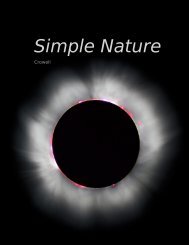Chapter 1 Conservation of Mass - Light and Matter
Chapter 1 Conservation of Mass - Light and Matter
Chapter 1 Conservation of Mass - Light and Matter
You also want an ePaper? Increase the reach of your titles
YUMPU automatically turns print PDFs into web optimized ePapers that Google loves.
a / Galileo Galilei (1564-1642).<br />
62 <strong>Chapter</strong> 1 <strong>Conservation</strong> <strong>of</strong> <strong>Mass</strong><br />
different substances will have different trajectories in the presence<br />
<strong>of</strong> gravity.<br />
A simplified drawing <strong>of</strong> a practical, high-precision experiment<br />
is shown in figure c. Two objects made <strong>of</strong> different substances are<br />
balanced on the ends <strong>of</strong> a bar, which is suspended at the center from<br />
a thin fiber. The whole apparatus moves through space on a complicated,<br />
looping trajectory arising from the rotation <strong>of</strong> the earth<br />
superimposed on the earth’s orbital motion around the sun. Both<br />
the earth’s gravity <strong>and</strong> the sun’s gravity act on the two objects. If<br />
their inertial masses are not exactly in proportion to their gravitational<br />
masses, then they will follow slightly different trajectories<br />
through space, which will result in a very slight twisting <strong>of</strong> the fiber<br />
between the daytime, when the sun’s gravity is pulling upward, <strong>and</strong><br />
the night, when the sun’s gravity is downward. Figure d shows a<br />
more realistic picture <strong>of</strong> the apparatus.<br />
This type <strong>of</strong> experiment, in which one expects a null result, is<br />
a tough way to make a career as a scientist. If your measurement<br />
comes out as expected, but with better accuracy than other people<br />
had previously achieved, your result is publishable, but won’t be<br />
considered earthshattering. On the other h<strong>and</strong>, if you build the<br />
most sensitive experiment ever, <strong>and</strong> the result comes out contrary<br />
to expectations, you’re in a scary situation. You could be right, <strong>and</strong><br />
earn a place in history, but if the result turns out to be due to a<br />
defect in your experiment, then you’ve made a fool <strong>of</strong> yourself.<br />
1.3 Galilean Relativity<br />
I defined inertial mass conceptually as a measure <strong>of</strong> how hard it<br />
is to change an object’s state <strong>of</strong> motion, the implication being that if<br />
you don’t interfere, the object’s motion won’t change. Most people,<br />
however, believe that objects in motion have a natural tendency to<br />
slow down. Suppose I push my refrigerator to the west for a while at<br />
0.1 m/s, <strong>and</strong> then stop pushing. The average person would say fridge<br />
just naturally stopped moving, but let’s imagine how someone in<br />
China would describe the fridge experiment carried out in my house<br />
here in California. Due to the rotation <strong>of</strong> the earth, California is<br />
moving to the east at about 400 m/s. A point in China at the same<br />
latitude has the same speed, but since China is on the other side<br />
<strong>of</strong> the planet, China’s east is my west. (If you’re finding the threedimensional<br />
visualization difficult, just think <strong>of</strong> China <strong>and</strong> California<br />
as two freight trains that go past each other, each traveling at 400<br />
m/s.) If I insist on thinking <strong>of</strong> my dirt as being stationary, then<br />
China <strong>and</strong> its dirt are moving at 800 m/s to my west. From China’s<br />
point <strong>of</strong> view, however, it’s California that is moving 800 m/s in<br />
the opposite direction (my east). When I’m pushing the fridge to<br />
the west at 0.1 m/s, the observer in China describes its speed as<br />
799.9 m/s. Once I stop pushing, the fridge speeds back up to 800














